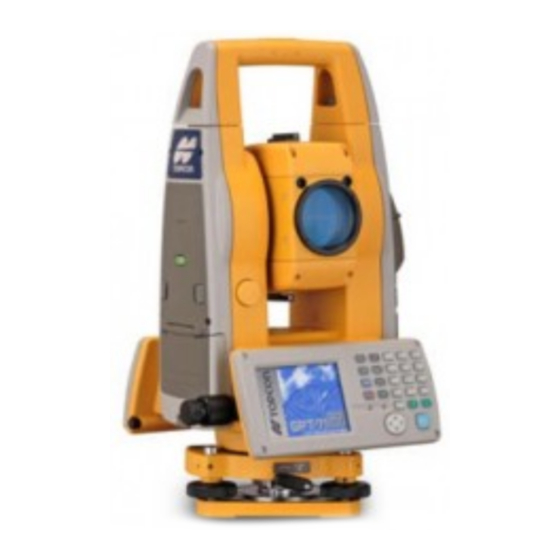
Summarization of Contents
General Handling Precautions
Handling and Operational Precautions
Covers instrument handling, setup, battery management, and power procedures.
Safety Cautions
Safety Warnings and Cautions
Details critical warnings and cautions regarding electrical hazards, fire risks, and proper usage.
Nomenclature and Functions
Nomenclature Overview
Identifies and illustrates the main parts of the instrument.
Display and Interface
Describes the instrument's display, main menu, and key elements.
Backlight and Key Light Settings
Explains how to adjust backlight and key illumination for optimal viewing.
RAM Data Backup Procedure
Details the process for backing up instrument data to prevent loss.
Hardware Reset Procedure
Outlines the steps for performing a hardware reset to resolve issues.
Cover Sensor Function
Explains the function and importance of the cover sensor for instrument operation.
Touch Panel Calibration
Guides on calibrating the touch panel for accurate input response.
Operating Panel Key Functions
Describes the function of each key on the instrument's operating panel.
Instrument Power Off Procedure
Details the correct procedure for powering down the instrument.
Function Key (Soft Key) Operations
Explains the functions assigned to the soft keys in different modes.
Star Key Mode Options
Describes how to access and use instrument options via the star key.
Auto Power Off Setting
Explains how to configure the automatic power-off feature to save battery.
USB Port Usage
Details how to connect and use the instrument's USB port for data transfer.
Preparation for Measurement
Power Connection Options
Explains how to connect onboard or external batteries for power.
Instrument Setup and Leveling
Guides on mounting, leveling, and centering the instrument on a tripod.
Powering On the Instrument
Details the procedure for turning on the instrument and accessing the main menu.
Battery Power Display
Explains how to interpret the battery power indicator and its implications.
Tilt Correction for Angles
Describes automatic correction for instrument tilt in angle measurements.
Systematic Error Compensation
Explains how to compensate for systematic errors in the instrument.
Entering Numerals and Letters
Details methods for inputting alphanumeric data into the instrument.
Data Memory Card Handling
Explains how to insert and extract the data memory card.
Active Sync for Data Synchronization
Guides on using ActiveSync for data synchronization between instrument and PC.
Standard Measurement Mode
Angle Measurement Procedures
Covers methods for measuring horizontal and vertical angles.
Distance Measurement Methods
Details various modes for measuring distances, including prism and non-prism.
Coordinate Measurement
Explains how to set occupied points and measure coordinates.
Data Output to Data Collector
Describes how to transfer measurement results to a data collector.
Data Output via REC Key
Explains how to output measurement data using the REC key.
Program Mode Operations
Backsight Orientation (BS) Setup
Guides on setting the backsight orientation angle using coordinate values.
Remote Elevation Measurement (REM)
Explains how to measure vertical distances to remote objects.
Missing Line Measurement (MLM)
Details how to calculate distances between points not directly visible.
Repetition Angle Measurement (REP)
Describes how to perform repeated angle measurements for improved accuracy.
Parameters Setting Mode
Parameter Setting Options
Lists and describes various parameters for measurement and communication.
Setting Specific Parameters
Provides examples of setting specific parameters like S/A BUZZER.
Check and Adjustment Procedures
Instrument Constant Check & Adjustment
Guides on checking and adjusting the instrument's constant for accurate measurements.
Optical Axis Checking
Explains how to check the alignment of EDM and theodolite optical axes.
Theodolite Function Checks & Adjustments
Details checks and adjustments for theodolite functions like levels and cross-hairs.
Setting Instrument Constant Value
Instructs on how to input the instrument constant obtained from checks.
Compensation of Systematic Errors
Explains the process for compensating systematic instrument errors.
Prism / Non-Prism Constant Correction
Setting Prism Constant Value
Guides on setting prism constant values for accurate distance measurements.
Setting Atmospheric Correction
Atmospheric Correction Calculation
Provides formulas for calculating atmospheric correction values.
Inputting Atmospheric Correction Values
Explains how to input temperature and pressure for correction.
Refraction and Earth Curvature Correction
Distance Calculation Formula
Presents formulas for distance calculation including refraction and curvature.
Power Source and Charging
On-board Battery BT-65Q
Details the removal, charging, and installation of the BT-65Q battery.
Message and Error Displays
Instrument Messages
Lists common messages displayed by the instrument and their meanings.
Instrument Errors and Countermeasures
Details error codes, their descriptions, and recommended countermeasures.
















Need help?
Do you have a question about the GTS-753 and is the answer not in the manual?
Questions and answers